Because it’s so tricky to cut, we usually see opal in simple cabochon form. Yet when sculpted, its iridescent rainbow calls up all kinds of things – dragonflies, peacocks, the eery beauty of glow-in-the-dark waves (bioluminescence).
Carving opal is like trying to sculpt stained glass. Not only is the material itself glass-like – fragile and unpredictable – its color is its glory. A sculptor has to let the stone dictate form. It takes a certain kind of artist to take this on – one not only skilled at three-dimensional form but blessed with infinite patience and a taste for living on the edge. One crack and there goes your time and investment.
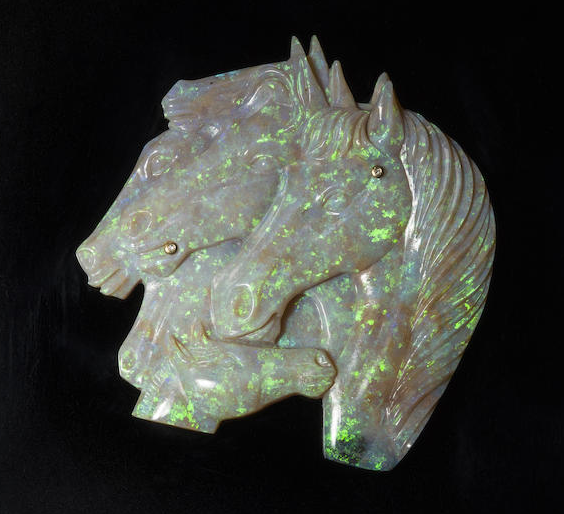
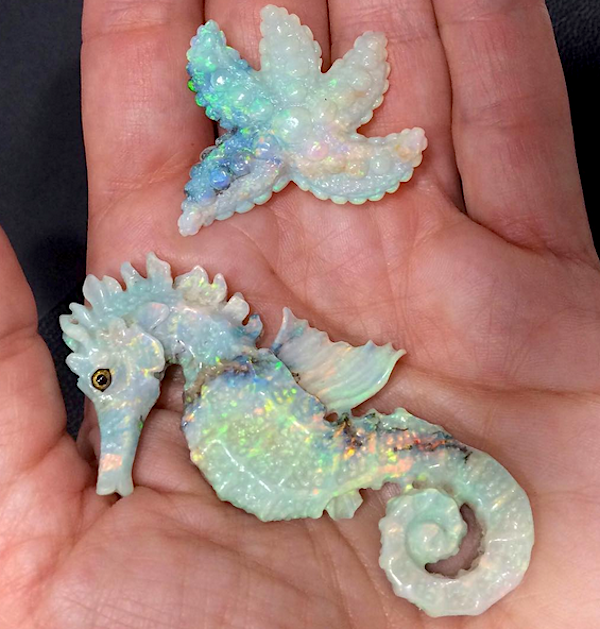
One family known for their skill and artistry in opal carving are the Pauly’s of Idar-Oberstein. Above are two beautiful examples by Erwin Pauly and his son Hans Ulrich Pauly. Erwin Pauly launched the family business in 1958 and became known as one of the best cameo carvers in Germany, helping establish Idar-Oberstein as the world center for lapidary art.
His son Ulrich (known as Uli) is equally talented, and so creative. Like his father, he is drawn to themes from nature and the animal world and a master of his material. Notice how he used what some might have considered a flaw in the opal to create shadow and depth, making that seahorse come alive.
“It’s such a gamble to work in opal,” studio jeweler Angela Conty once told me. Conty has carved it herself and designed around opals carved by others, including Daniela L’Abbate. While they weren’t the first to master this art form, women lapidaries are proving particularly adept at it.
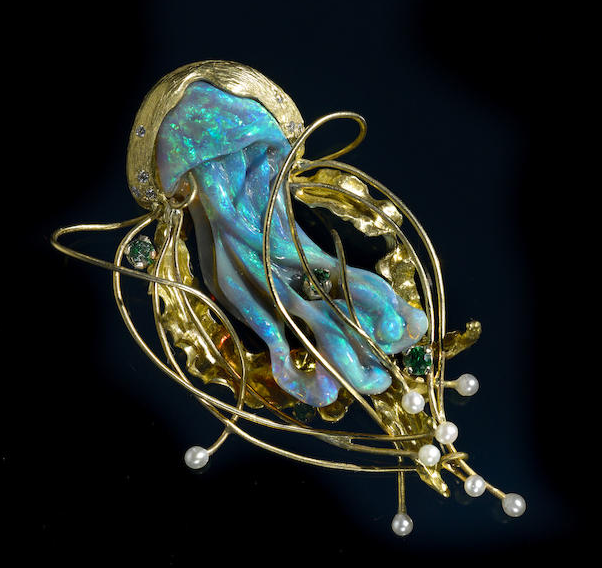
“Carving in opal or sunstone or other multi-colored stones is like knitting a sweater,” gem artist Robert Chaplin once told me. When you’re carving gems, he said, “you can make a color pattern or a texture pattern. If you’re making texture patterns, you don’t want color to interrupt that.” Opal will interrupt you with color at every turn.
No wonder carved opal is so rare in jewelry. Yet some amazing examples have appeared at auction in recent years.
One early master of this art form was German carver Wilhelm Schmidt (1845-1938). In 2015, Bonhams sold off a fascinating collection of late-19th-century work attributed to Schmidt, including this cameo carved – front, side and back – from opal on matrix, set in a gold brooch.
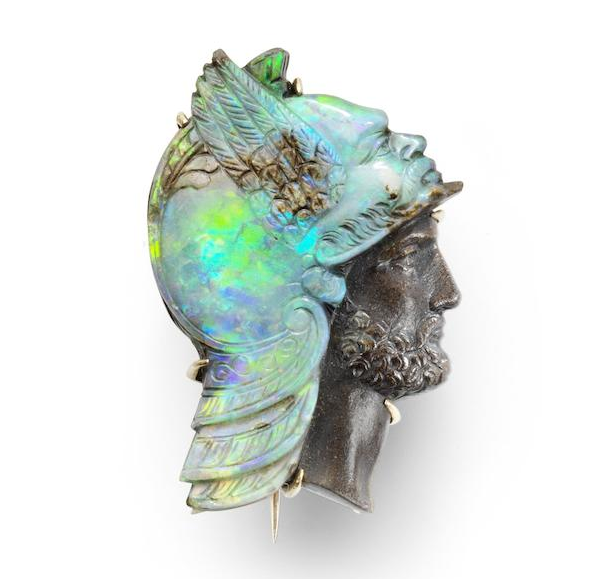
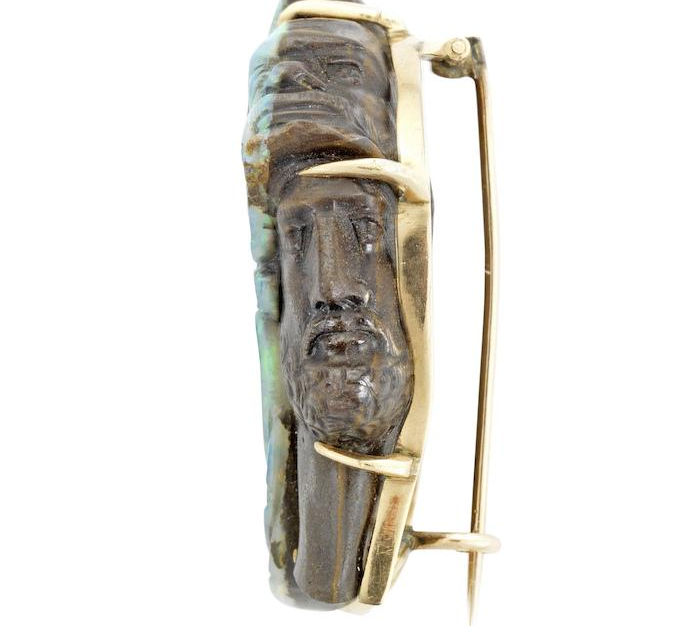
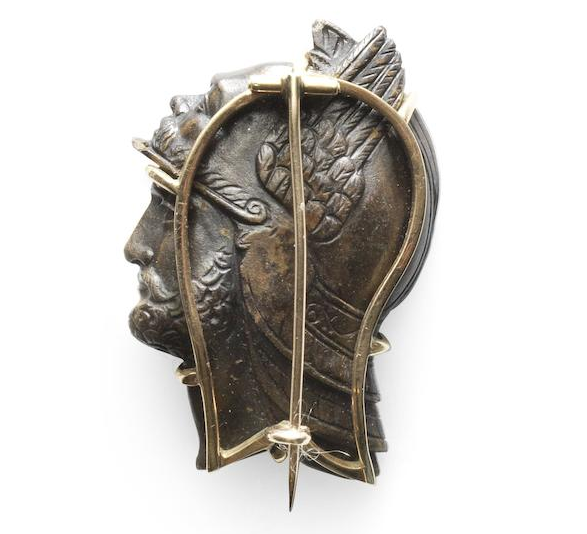 Opal cameo brooch (front, side and back views), late 19th century, probably by Wilhelm Schmidt, sold at Bonhams London in April 2015 for $17,497
Opal cameo brooch (front, side and back views), late 19th century, probably by Wilhelm Schmidt, sold at Bonhams London in April 2015 for $17,497
“Opal cameos, if rare, were not unknown (in the 19th century) but Schmidt had invented a novel technique,” Gertrud Seidmann wrote in her 1988 book Wilhelm Schmidt: The Last Neo-classical Gem-Engraver. Instead of carving the whole cameo from precious opal, he used rough with a thin layer of precious opal overlaying the matrix, the same way contrasting layers of agates were traditionally used in cameos, to set off the background. As you can see, Schmidt often carved the matrix as well – even the backs.
Born in the gem-carving haven of Idar-Oberstein in 1835, Schmidt began training in the art of cameo carving at age 15. Settling in London, he engraved cameos from quartz, sardonyx, jasper, labradorite, and moonstone, but became known for his highly-unusual carvings in opal matrix. This quirk accounts for why we know his name at all. Even though Schmidt produced for top jewelers of his day, including John Brogden, Child and Child, Guilliano, he never signed anything. Cameos attributed to him are now in the British Museum and Natural History Museum in London.
Following in his wake, another German carver Wilhelm Lucas Von Cranach (1865-1918) took to carving faces in opal too, making a name for himself in a far less classical style.
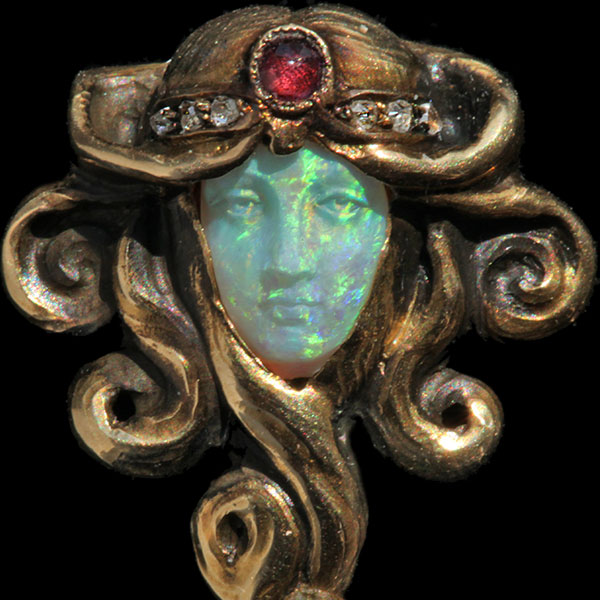
Von Cranach took advantage of the opal craze in Europe at the turn of the century, when Art Nouveau took off. While most Germans were working in the more geometric Jugendstil style, Von Cranach, a portrait and landscape painter, was attracted to the mystical symbolism and female forms of the Parisian school led by René Lalique. But unlike the ethereal creatures French jewelers were making, Cranach’s females were strong and forbidding, like this Medusa that appeared at the Tadema Gallery.
You can see the influence of Art Nouveau jewelry on contemporary designer Angela Conty’s work, in the fluid lines and focus on nature. By carving her own gems, then fabricating the gold around them, Conty learned to create very organic pieces. In her case, the opal absolutely dictates the design, and that’s part of her creative journey.
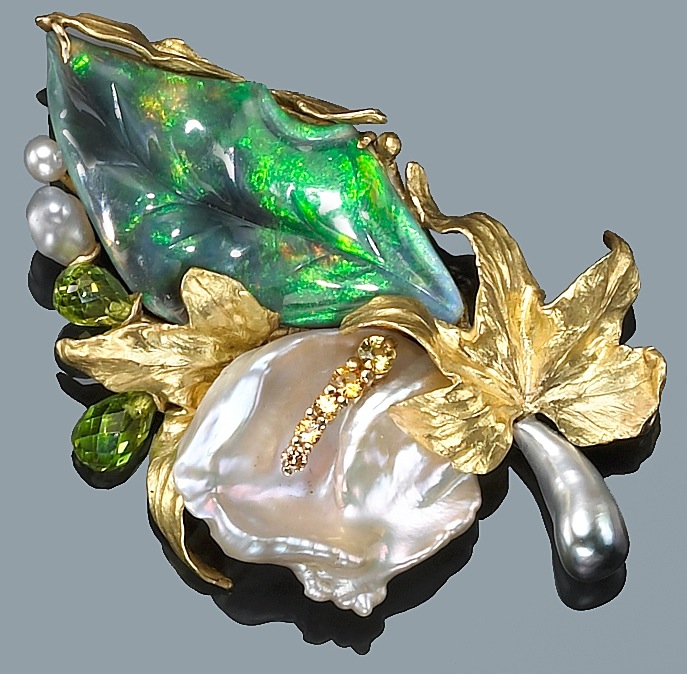
While she has carved and set many kinds of gemstones, opal has become her signature, as it was for Schmidt more than a century before. I first met Conty at the Tucson Gem Shows years ago, when she was showing her jewelry at the AGTA show. You don’t meet many designers who produce every aspect of their jewelry by hand, right down to carving the stones, and the fact that she was doing this with opal got my attention.
“I’ve always loved opal,” Conty told me. “It’s not too hard, but it has its own problems.” Early on, she turned to opal expert Paul Downing, who was “very generous” about sharing information.
“Picking rough was a real challenge from the beginning,” she admitted. “It’s such a gamble to work in opal, because there is no guarantee where that vein is. The rough may be covered in pocks or common opal. You may see a vein on the edge of it, but don’t know where it goes.”
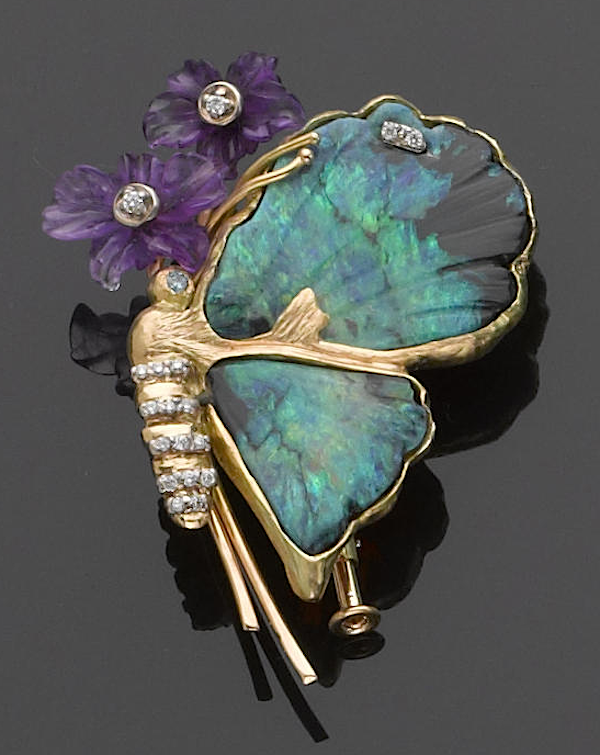
Then there’s the problem of setting the delicate carving so it can actually be worn. “The structure has to be strong enough to protect the opal, so I try to put enough gold around it that no matter where it’s dropped, the gold will hit first,” Conty said. “But that’s the way I like to work – very three-dimensional and solid and fluid.”
Her work has been showing up at Bonhams’ auctions for the last several years. It doesn’t always meet the reserve and often goes for prices that make me cringe, knowing how much handwork goes into these pieces. But the butterfly brooch above, sold around the time those JAR butterflies at the Met were getting major press, shows there is still demand for labor- and gem-intensive one-of-a-kind pieces, even when they’re designed and made by the not-yet famous.
You can find more amazing opal jewels on my Opal Fever board on Pinterest.
Recommended books on opal and gem carving
Opals (3rd edition) by Fred Ward
Gem Cutting, a Lapidary’s Manual by John Sinkankas
Opal Idendification and Value by Paul Downing
Tools to get you started
Dremel flex shaft rotary tool attachment
Sintered diamond burrs (more expensive but longer lasting)

